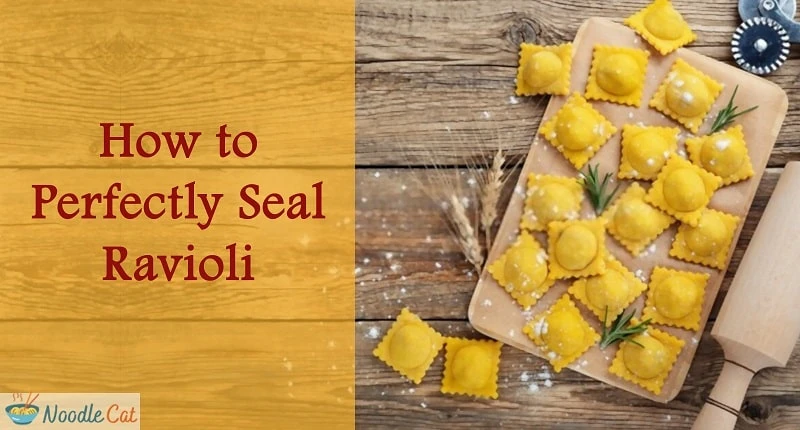by Daisy Dao
Just like canned soup and instant noodles, ravioli is one of the ideal last-minute meals. It is the perfect dish for one of those evenings when you’re lazy, tired, and too broke to seek out new ingredients in the market. There are essentially two available types of ravioli. One is the prepacked and ready-to-eat ravioli while the other is the thin-skinned homemade ravioli. The difference between the two is clear. Each meal, however, has its pros that favor its consumption. The best way to learn how to perfectly seal ravioli is by preparing fresh homemade ones. Here is further insight into the tips and tricks behind making perfectly sealed ravioli.
Contents

When making ravioli, the main ingredients you must have are all-purpose flour, eggs, salt, and the filling of your choice. It is also quite helpful if you have a rolling pin and stand-mixer attachment. Though the latter and any other pasta-making tool may be a bit of an investment, they are definitely your money’s worth if you are a regular user. Fresh home-made ravioli is easy-to-freeze which makes it a convenient meal to enjoy during one of those lazy moments. In addition, it is simple to make especially if you already have a ravioli maker and ravioli cutter to streamline the entire process. Though the overall process is pretty straightforward, it is a kind of technique you develop and become adept with over time. You will soon be able to get creative with sauces and fillings, attempt different shapes and sizes or even try out the revered runny egg yolk-filled ravioli.
Firstly, the dough is just as a critical component as the filling. Most store-bought ravioli happen to suffer from thick gum-like skins. They lack the tender and translucent elasticity that is seen in their handmade counterpart.
Secondly, try to avoid watery fillings. While preparing your homemade ravioli, be careful when pouring in your butter, cream, or oil. Adding too much may result in a watery and loose ravioli. In addition, the dough may end up too sticky to handle and difficult to seal perfectly.
Thirdly, try making your filling flavorful and attempt to use a lot of it. One of the major pros of making ravioli is creating your own tasty filling. Basically, the filling should be good enough to eat with a spoon. Once you obtain that perfect filling, you should not hold it back. Stuff the dough as much as you want until it gets stretched pretty tight. This is the ideal balance for filling up the dough.
Last but not least, ensure that you are on the lookout for trapped air bubbles. You can eliminate the trapped air bubbles using different methods as long as you press out as much air as possible. However, do not fuss over air bubbles that remain trapped as your ravioli will survive.
The first step entails mixing your dough and wrapping it up tightly in plastic to allow it to rest. Meanwhile, you can concentrate on preparing your filling. Approximately one tablespoon is enough for filling up each ravioli. You can also go for an eyeballing amount, in which case, you can use pastry or a zip-lock bag which is faster and neater. If you lack these tools, simply keep a measuring spoon on standby.
Lastly follows the sealing process. At this stage, you can use a ravioli maker or a pastry brush and water to seal the dough. Some people use egg whites instead of water if there is any extra left lying around from making the filling. The other option that will suffice is having a ravioli mold and rolling pin. Once you acquire all the needed tools, you can now start rolling the dough. Try to keep the dough from drying out by working with just a quarter of the entire dough at a time. You can keep the rest of the dough covered with plastic or using a kitchen towel.
Using a rolling pin, roll out a thin layer that is just 1/16th of an inch. If you have a pasta maker, this is usually the second-to-last setting on it. Avoid rolling it any thinner as you may end up with a less well-balanced ratio of filling to the dough which is far less aesthetically appealing. The dough should ideally take up almost the entire width of the pasta roller that is between four to five inches in width. Once you have the thin layer, proceed to lay the dough out onto a lightly floured large flat surface and cut it in half. Semolina flour is perfect as it won’t get your dough sticky in case it gets moistened. You should be able to obtain at least twelve ravioli from each quarter of dough. Beyond this stage, the steps differ depending on if you have a ravioli maker or are working by hand.
Firstly, place the metal base of the ravioli maker in front of you and spread out the first sheet of dough on top. Proceed to take the plastic mold and gently press it down to form depressions in the dough. You should be as quick as possible at this stage to prevent the dough from drying out and becoming brittle. If you happen to press it down too hard and the dough ends up tearing, you can always ball it again and roll it through the pasta maker.
Once you obtain the perfect depressions, place about one tablespoon of filling in each depression. Strive to keep the filling inside the depression as the flat perimeter is what your second sheet of dough will stick to. Gently wipe away any excess filling with your finger or a small clean cloth. Afterward, proceed to rap the mold on the table to remove any air bubbles.
At this stage, you can now lay the other half of your sheet dough over the mold surface. Try to push out any extra air by pressing with the flat of your hand which will help in making the perfect seal. You can then use a rolling pin in running over the surface of the dough to make the ridges beneath more visible. Once you’ve done this, you can gently peel away the mold after flipping it over.
In case some ravioli gets stuck on the mold, try tapping one edge against the table for it to come loose. At this stage, you can place the homemade ravioli on a sheet tray and freeze it up for later use after wrapping it in plastic. If the dough is well perforated to pull apart, then proceed to do so. If not, then you may need a ravioli cutter to slice the dough up into individual pieces. Slicing the up also aids in the sealing and results in a unique shape.
Firstly, fold the sheet of dough along its midline, make a light crease and then reopen it. Place 6 even tablespoons of filling across the lower half that is one-and-a-half inches in diameter and a half an inch apart. Moisten the dough lightly on its edges with water and a pastry brush. Proceed to fold it over along the crease and press the folded point outward to expel excess air. You can now gently pat the dough down around each lump of filling to create a perfect seal. Finally, use a ravioli cutter or stamp to slice it into even squares.
The only step left involves tossing it into a pot of boiling water and allowing it to cook for 3 minutes. Serve it with any sauce of your choice and enjoy.
 |
 |
 |
 |
 |
 |
 |
 |

About Daisy Dao
Daisy grew up on the beautiful Honolulu island where she often found herself spending most of her day enjoying the ocean scent in sea waves. As such, Daisy came to appreciate the art of cooking seafood. She has experimented with baking, roasting, broiling, poaching, grilling (and every other cooking technique you can think of); and with all kinds of spices too. Now she is ready to present her experience: the art of cooking healthy food without any pre-packaged ingredients; food product recommendations for people who need a bit more guidance on what goes into their bodies; how to maintain an active lifestyle without having to give up your favorite foods!
Check for FREE Gifts. Or get our Free Cookbooks right now.
Disable the Ad Block to reveal all the recipes. Once done that, click on any button below
 |
 |
 |
 |